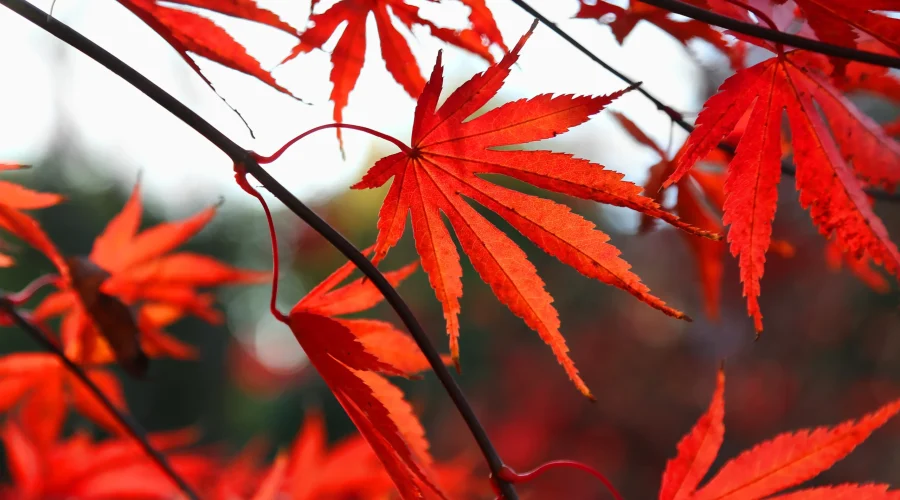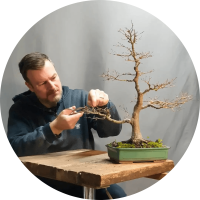Acer Palmatum Bonsai Care Guide (Japanese Maple)

The Acer palmatum — better known as the Japanese Maple — is one of the most beloved species in the bonsai world. Its delicate, hand-shaped leaves burst into brilliant reds, oranges, and golds in autumn, making it a symbol of elegance and tranquillity. But its beauty requires thoughtful, attentive care.
This guide brings together expert knowledge and the techniques demonstrated in our full video tutorial, helping you understand exactly how to support your Japanese Maple through every season.
Watch the Full Japanese Maple Care Tutorial
Acer Palmatum at a glance
Native to Japan, Korea, and parts of China, the Japanese Maple thrives in mild, temperate climates with soft light and steady moisture. Its moderate growth rate makes it perfect for beginners who are ready to learn essential bonsai techniques, from controlled pruning to careful watering and seasonal adjustments.
The tree adapts beautifully to styles such as Informal Upright (Moyogi) or Cascade (Kengai), and its graceful branching structure allows for artistic shaping over time. Each specimen grows into its own personality, making the species one of the most rewarding in bonsai artistry.
Thinking about growing your own Japanese Maple from the beginning?
Explore our young Acer palmatum pre-bonsai and start shaping your tree today.
How often should I water an Acer palmatum bonsai?
Watering a Japanese Maple is all about balance. The tree enjoys consistently moist soil, but soggy conditions will quickly lead to fungal issues.
Seasonal watering guide (as shown in the video):
Summer: water daily, or twice a day during extreme heat
Spring & autumn: water every 2–3 days
Winter: water less, but never let the soil dry out completely
Use a watering can with a fine rose to avoid disturbing the soil. Water early in the morning to help the tree absorb moisture before the strongest sun.
A useful trick is to insert a wooden chopstick into the substrate for 10 minutes, if it comes out dry, water the tree. If it is moist, wait.
Overwatering is just as harmful as underwatering: too much moisture can encourage fungus, especially in humid climates.
How much light does an Acer palmatum need?
Japanese Maples love light, but their delicate leaves scorch easily in strong midday or afternoon sun.
Ideal light positioning:
Full morning sun
Light shade during hottest hours
Above 30°C (85°F): provide shade cloth or place under taller trees
Ensure excellent airflow, it prevents powdery mildew and fungal infections
In winter, protect the tree from harsh winds and frost. If temperatures fall below –5°C, move the bonsai to a sheltered location such as:
a cold frame
an unheated greenhouse
a covered terrace
Short indoor display is fine (1–2 days), but indoor living will weaken the tree.

Ideal temperature range for Acer palmatum
The Japanese Maple thrives between 10°C and 25°C (50–77°F). Moderate, stable temperatures support vibrant leaf colour and steady growth.
Temperature notes:
Heat above 30°C may cause leaf scorch → provide shade and steady watering
Wind can dry and damage foliage → shield during heatwaves
Frost below –5°C damages roots → protect the pot
Winter dormancy is essential → never overwinter indoors
Fertilising your Acer palmatum
Fertilising depends on your goals:
For fast growth / trunk thickening
- Use high-nitrogen fertiliser in spring
For balanced, refined growth
- Apply a normal bonsai fertiliser every 2–3 weeks
Late summer & autumn
Switch to low nitrogen
Helps wood harden before winter
Avoid heavy or frequent fertilising, it produces oversized leaves and long internodes.
Both organic pellets and diluted liquid fertilisers work well; consistency matters more than quantity.
Do I need to prune my Acer palmatum? Yes. And technique matters.
Pruning is essential to maintain compact growth and refine branch structure.
Pinching technique:
New buds produce two leaves → leave the first pair, remove the second pair
External buds (tips) are more vigorous → prune more aggressively
Internal buds are weaker → often no need for secondary leaf removal
Partial defoliation
Helps increase ramification and structure.
Use sparingly, only on healthy trees.
Seasonal pruning strategy:
Spring: pinch new shoots to refine structure
Summer: avoid heavy pruning (risk of dieback)
Late winter / early spring: structural pruning, before buds open
Wiring:
Best during dormant season
Check regularly to avoid wire marks
Use guy-wires for major bends
When should I repot an Acer palmatum?
Repotting is crucial for root health and long-term development.
Best time:
- Early spring, just as buds begin to swell
Frequency:
- Young trees: every 1–2 years
- Mature trees: every 3–5 years
Technique:
- Remove all old soil
- Cut thick roots
- Preserve fine feeder roots
- Use slightly acidic to neutral substrate (pH 5.5–6.5)
Recommended mix:
- akadama
- pumice
- kiryu
After repotting, keep the tree in light shade for 1–2 weeks.
Common Problems
Leaf scorch:
- Too much sun
- Heatwaves
- Dry wind
- Irregular watering
Weak/pale growth:
- Low nutrients
- Poor soil structure
Early leaf drop:
- Heat stress
- Drought
- Root loss
- Wind exposure
Pests (very common in spring):
- aphids
- mites
- scale insects
Treat quickly with neem oil or insecticidal soap.
Fungal issues:
- powdery mildew
- verticillium wilt
Prevention: airflow, partial shade, careful watering.
With steady attention, your Japanese Maple rewards you with delicate structure, seasonal colour, and a calm, harmonious presence.

Written by Luca Valagussa
Founder and bonsai master of Treevaset
Formerly in finance, Luca turned his lifelong passion for bonsai into his profession to make bonsai art simple, inspiring, and accessible to everyone.
